Japanese
English
- 有料閲覧
- Abstract 文献概要
- 1ページ目 Look Inside
- 参考文献 Reference
組織で産生された二酸化炭素は,その大半が炭酸水素イオンに変換されて血液中を運ばれ,肺で再び二酸化炭素に変換されて排出される。肺胞レベルでのガス拡散障害,換気血流比不均衡,シャントは,いずれも二酸化炭素を溜める方向に作用する。通常は動脈血二酸化炭素分圧が上昇すると,フィードバック機構をもつ呼吸調整回路がすみやかに換気量を増大させ,二酸化炭素排出を増やして二酸化炭素分圧を正常範囲内に保つ。高二酸化炭素血症となるのは,肺胞レベルの病態による二酸化炭素貯留が代償性過換気による二酸化炭素排出を上回る場合か,呼吸調整回路の異常により低換気となった場合,および疾患により肺と周囲の構造が変化して肺胞低換気を生じた場合である。
Carbon dioxide produced in tissues is mostly converted to bicarbonate ions and transported in the bloodstream to the lungs, where it is again converted to carbon dioxide and expelled. Impaired gas diffusion at the alveolar level, ventilation-perfusion mismatch, and shunts all result in accumulation of carbon dioxide. Normally, when the partial pressure of carbon dioxide in arterial blood rises, respiratory control circuits with feedback mechanisms quickly increase ventilation to increase carbon dioxide emission and maintain normocapnia. Hypercapnia occurs when carbon dioxide retention due to alveolar pathology exceeds its removal by compensatory hyperventilation, when abnormalities in the respiratory control circuit cause hypoventilation, and when pathological changes in the lung tissues and surrounding structures cause alveolar hypoventilation.

Copyright © 2022, MEDICAL SCIENCES INTERNATIONAL, LTD. All rights reserved.


